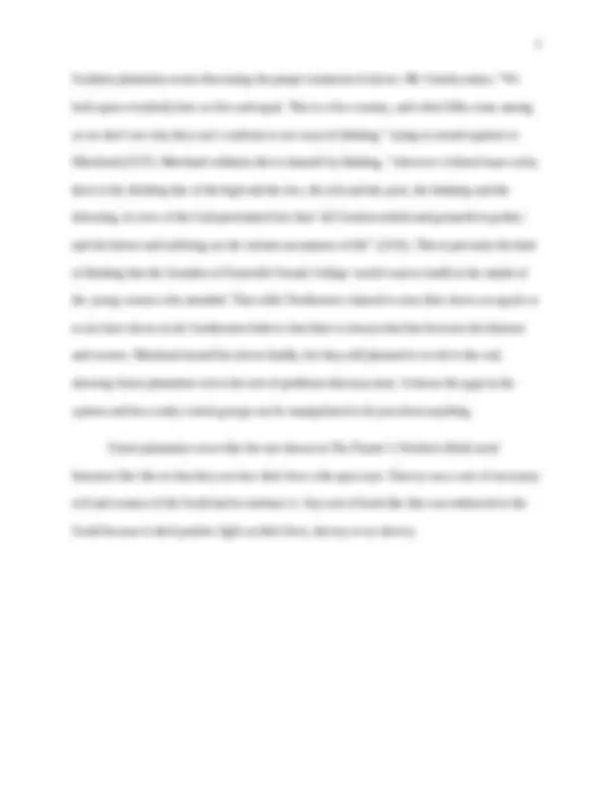



Study with the several resources on Docsity

Earn points by helping other students or get them with a premium plan


Prepare for your exams
Study with the several resources on Docsity

Earn points to download
Earn points by helping other students or get them with a premium plan
Community
Ask the community for help and clear up your study doubts
Discover the best universities in your country according to Docsity users
Free resources
Download our free guides on studying techniques, anxiety management strategies, and thesis advice from Docsity tutors
Group Project guide Material Type: Notes; Class: Am Lit: Realism to Contemp; Subject: English; University: Longwood University; Term: Fall 2010;
Typology: Study notes
1 / 3

This page cannot be seen from the preview
Don't miss anything!


Jen Boston, Marissa Cole Dr. Miller, Eng. 327 11/17/ The Planter’s Northern Bride: Critical Reception Caroline Lee Hentz spent most of her life living in the south while slavery still reigned. She became famous as a writer after having to work alongside her unsuccessful husband. In 1852, the abolitionist movement was stronger than ever thanks to the publication of Uncle Tom’s Cabin, by Harriet Beecher Stowe. This novel threatened the existence and peace that Southern society held, and more than anything, it was a direct attack on their lifestyles. In response to Stowe’s novel, Hentz published, “The Planter’s Northern Bride,” which advocated anti- abolitionism and negated the claims that Stowe made in her book. Caroline Hentz was not actually a native southerner, but her defense of southern society is strong and suggests how strong her influence as a white woman in the south was. Her choice to publish her novel in Philadelphia, a city decidedly in the North stemmed both from her northern heritage, but also knowing that her audience would be wider and more effective by publishing in the North. However, it has been noted that Hentz’s novels were bringing in the only income for her family, and many people believe that her stance on pro-slavery was deliberate in order to sell more books and to continue being published (Cummins, 19). Despite her reasons for writing though, Hentz’s novel, “The Planter’s Northern Bride,” was extremely popular and well-received. The critical reception was just as popular as its rival novel although some critics ‘felt that the South was portrayed unrealistically, in that Hentz had taken up none of
its faults, most were relieved to have a well known writer responding to Stowe's overwhelmingly successful novel.’5" (Cummins, 20). Hentz’s novel has its short comings, especially when considering more elements of her background. Critics of her novel often note that Hentz was a fairly poor white woman living all over the United States, in both Northern and Southern states. She never owned a plantation or any slaves herself, and many of the people that she associated with were in a similar status. Some critics believe that her pro-slavery attitude is undermined by the fact that she has had no true experience with it, and therefore she can neither accurately depict the South, nor the relationships between Slave and Master. Hentz argued that she knew more about the system than given credit for, but primarily she knew more about it than Stowe did, having experienced Southern lifestyles first-hand. The Planter’s Northern Bride by Carolina Lee Hentz is something that the women the Le Vert Literary Society would read because it deals with the different issues plantation wives would have to endure. Women at Farmville Female College attended for a higher education, but many of them still dwelt on the idea of marrying a plantation owner and taking on the roles of a sophisticated Southern lady. People in the south were obviously pro slavery due to the important role they played in maintaining plantations. The Planter’s Northern Bride following a Northern woman who married a plantation owner and pities the slaves even though her husband does not treat them unjustly. She eventually realizes that the slaves are not in a terribly foul disposition and grows to accept slavery. Later, she discovers a plot by local abolitionists to help her slaves’ revolt and murder both her and her husband in an act of freedom and liberation. The point here is to show how even the most mildly punished slaves could revolt and take up arms against their masters. In the first chapter, its shows a Northerner, Mr. Grimby, and Mr. Moreland, the